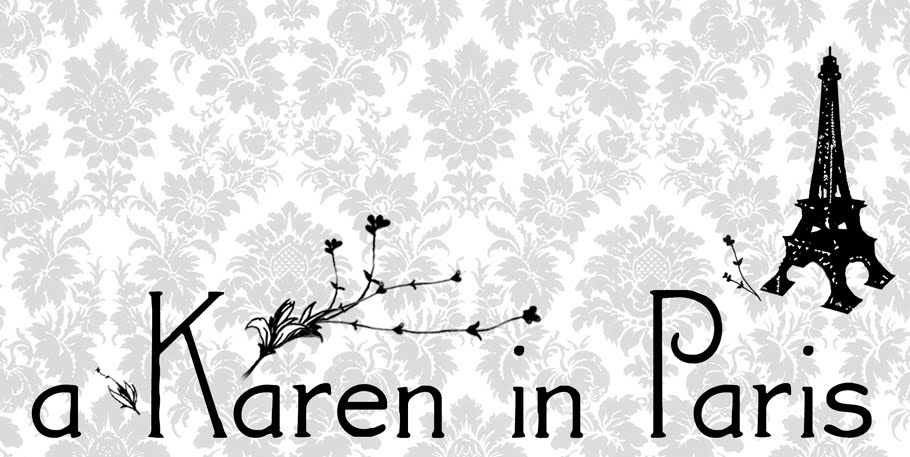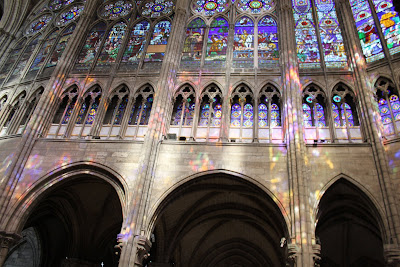I went to the Basilque St. Denis (Saint Denis Basilica) yesterday. (These blurbs are written with help from Wikipedia & the pamphlet from the basilica) St. Denis is a patron saint of France, and he was archbishop of Paris in the third century. In approximately AD 250, he was martyred. It is said that after his head was chopped off, St. Denis picked it up and walked six kilometers and preached a sermon the entire way. The place where he stopped his sermon and "actually" died, was originally marked with a small shrine, and has evolved into the basilica. The French name "Denis" derives from the ancient name Dionysius.
It's said that the basilica is the birthplace of Gothic architecture.
"In the 12th century the Abbot Suger rebuilt portions of the abbey church using innovative structural and decorative features that were drawn from a number of other sources. In doing so, he is said to have created the first truly Gothic building. The basilica's 13th century nave is also the prototype for the Rayonnant Gothic style, and provided an architectural model for cathedrals and abbeys of northern France, England and other countries." (Wikipedia)
The kings, although many are buried at the basilica, were not coronated here; Queens, however were commonly crowned here. [As I'm sure you remember from my trip to Reims, the kings are coronated at the Cathedral Notre Dame de Reims.] :)
"The Basilica of St Denis is an architectural landmark as it was the first major structure of which a substantial part was designed and built in the Gothic style. Both stylistically and structurally it heralded the change from Romanesque architecture to Gothic architecture. Before the term "Gothic" came into common use, it was known as the "French Style" (Opus Francigenum)." (Wikipedia)
"As it now stands, the church is a large cruciform building of "basilica" form, that is, it has a central nave with lower aisles and clerestory windows. It has an additional aisle on the northern side formed of a row of chapels. The west front has three portals, a rose window and one tower, on the southern side. The eastern end, which is built over a crypt, is apsidal, surrounded by an ambulatory and a chevet of nine radiating chapels."
 |
The light from the windows played on the floors and walls...it was incredible. |
The basilica became the burial place of the French Kings. All but three kings from the 10th to the 18th centuries are buried there, as well as many from the previous centuries. Also buried there are the children and families of many kings, as well as Marie Antoinette, and Catherine de'Medici. The French Revolution was a dark time....many kings' and queens' resting places were disturbed and the remains desecrated, or covered with lime to speed up decomposition.
"The bodies of the beheaded King Louis XVI, his wife Marie Antoinette of Austria, and his sister Madame Élisabeth were not initially buried in Saint-Denis, but rather in the churchyard of the Madeleine, where they were covered with quicklime.
The few remains, a few bones that were presumably the king's and a clump of greyish matter containing a lady's garter, were found on January 21, 1815, brought to Saint Denis and buried in the crypt." (Wikipedia)
 |
| Monument to Louis XVI and Marie Antoinette |
 |
| The ossuary |
"The abbey church contains some fine examples of cadaver tombs. The effigies of many of the kings and queens are on their tombs, but during the French Revolution, these tombs were opened by workers under orders from revolutionary officials. The bodies were removed and dumped in two large pits nearby and dissolved with lime. Archaeologist Alexandre Lenoir saved many of the monuments from the same revolutionary officials by claiming them as artworks for his Museum of French Monuments.
Napoleon Bonaparte reopened the church in 1806, but allowed the royal remains to be left in their mass graves. In 1817 the mass graves containing the remains were opened, but it was impossible to distinguish any one from the collection of bones. The remains were therefore placed in an ossuary in the crypt of the church, behind two marble plates with the names of the hundreds of members of the succeeding French dynasties that were interred in the church duly recorded." (Wikipedia)
 |
| This woman, wearing a respirator mask, cleaned around one area for the entire 2 hours I visited the church. |
 |
| Henry II and Catherine de'Medici |
 |
| Monument to Catherine De'Medici and Henry II |
Clovis I
Some of the kings/queens buried in the basilica. I've included links to Wikipedia. :)
- Clovis I (465 - 511)
- Childebert I (496 - 558)
- Arégonde (c.515 - c.573)
- Fredegonde (Wife of Chilperic I of Neustria) (? - 597)
- Dagobert I (603 - 639)
- Clovis II (635 - 657)
- Charles Martel (686 - 741)
- Pippin the Younger (714 - 768) and his wife Bertrada of Laon (726-783)
- Carloman I King of the Franks (c.751 - 771)
- Charles the Bald (823 - 877) (his monument was melted down) and his wife, Ermentrude of Orléans (823 - 869)
- Carloman (866 - 884)
- Robert II the Pious (972–1031) and Constance of Arles (c. 986 - 1032)
- Henry I (1008-1060)
- Louis VI (1081-1137)
- Louis VII (1120-1180) and Constance of Castile (1141-1160)
- Philip II Augustus (1180-1223)
- Charles I of Naples (1226 - 1285), king of the Two Sicilies (1266-85). An effigy covers his heart burial.
- Philip III the Bold (1245 - 1285)
- Philip IV the Fair (1268 - 1315) and Isabella of Aragon (1247 – 1271)
- Leo V of Armenia (1342 - 1393)
- Louis XII of France (1462 – 1515)
- Francis I (1494 - 1547)
- Henry II (1519 - 1559) and Catherine de' Medici (1519 – 1589)
- Francis II (1544 – 1560)
- Charles IX (1550-1574) (no monument)
- Henry III (1551 -1589) (heart burial monument)
- Henry IV (1553 - 1610)
- Louis XIII (1601 – 1643)
- Louis XIV (1638 – 1715)
- Louis XV (1710 – 1774),
- Louis XVI (1754 – 1793) and Marie Antoinette (1755 – 1793)
- Louis XVII (1785 - 1795) (Only his heart. His body was dumped into a mass grave)
- Louis XVIII (1755 - 1824)
xo, aKiP
















Hey Karen!
ReplyDeleteI love your Basilique St. Denis photos! I would like to use them in a show I'm working on! Please shoot me an email if you're interested samantha.e.corey@gmail.com
-Sam